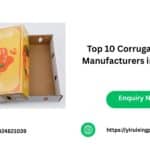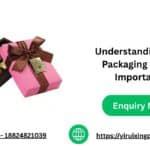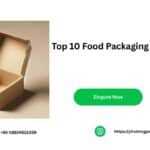Food packaging is not merely an attractive label; it is a barrier that blocks contaminants, keeps the product fresh, and also acts as the first line of defense against the contamination of food. For North America, the value of the food packing market was around USD 111.8 billion in 2024, which was mainly due to convenience foods, meal delivery by e-commerce, and the demand for recycled and safe materials. The food-packaging market is even more extensive globally (estimated at USD 505 billion in 2024) and is still expanding due to the popularity of flexible and eco-friendly solutions. These market forces, along with regulatory scrutiny, are making it necessary for the U.S. manufacturers to very strictly control their cost, performance, and food-contact safety measures.
Table of Contents
ToggleWhy “food-safe” matters — rules, risks and recent moves
A packaging material that is safe for food must conform to both chemical and microbiological standards if it is in contact with food. In the U.S., the methods for evaluating materials, coatings, adhesives, and recycled content, as dictated by the FDA’s guidance and food contact substance (FCS) framework, are set up. Manufacturers have the option of either depending on already existing FDA approvals or presenting FCS notifications for the introduction of new substances or the application of novel uses. This regulatory framework dictates formulation, testing, and documentation for each food box line.
There are two significant trends on the side of regulations/markets to consider:
- The big switch over from using PFAS (water-/grease-resistant “forever chemicals”) in fast-food wrappers and similar products, which are gradually becoming a thing of the past, has already prompted a change in the selection of suppliers.
- The legal battles and campaigns concerning phthalates and other plastic additives are becoming more and more intense, thus indirectly forcing the quicker use of recyclates that comply with food-contact chemistry guidance.
Key facts (at a glance)
- North America food-packaging marketplace (2024): ~USD 111.8B; non-stop elevate predicted (mid-single-digit CAGR).
- Global food-packaging market (2024): ~USD 505B (highlights the dimensions of the marketplace and the need for R&D Investment. Fortune Business Insights
- The FDA continues a public list of food touch substances (FCSs) and the extraordinary submission pathways for them: that is a requirement for many new substances.
- The U.S. has already seen an industrial pass far away from PFAS in foodservice packaging, and companies are working on new styles of grease barriers.
Comparative table — leading U.S. Food box manufacturers (2024 snapshot)
| Company | 2024 (approx.) revenue/ net sales | Specialty/strength | Notes on food-safety focus |
| International Paper | Net sales: $18.6B (2024) | Containerboard, corrugated food boxes, paperboard foodservice packaging | Large compliance teams; investing in sustainable fiber and food-contact alternatives |
| Graphic Packaging | Multi-billion (company reports emphasize large consumer & foodservice packaging growth; see 2024 report) | Paperboard cartons, shelf-stable food boxes, custom-printed food containers | Reports highlight circulatory initiatives and innovation-driven sales |
| Pactiv Evergreen | Quarterly net revenues ~ $1.3B (Q2 2024 example); large foodservice footprint. | Rigid, thermoformed food trays, takeaway containers, disposable food boxes | Strong presence in foodservice; emphasizes material choices for safety and performance. |
| Sonoco | Global packaging company with diversified food & consumer packaging lines (annual reports 2024). | Paper, flexible, and thermoformed packaging for food brands | Longstanding compliance programs and supplier testing protocols. |
| Amcor/Berry/Sealed Air (US ops) | Large global players with major U.S. operations; consolidation in 2024–25 affected market structure. | Flexible films, barrier packaging, molded fiber boxes | Investment in PFAS-free barrier technologies and recyclable films. |
Revenues and company details mentioned above are taken from company reports, SEC filings, and industry summaries for 2024–2025 (see sources). In cases where firms belong to larger multinational groups, the U.S. food-packaging business might represent only a portion of the entire sales.
What separates a “food-safe” food box from a typical box?
- Approved materials & documented FCS pathway — For every polymer, additive, adhesive, or coating that is used, examples of safety or approval through FDA inventory/notifications must be provided.
- Barrier performance without harmful chemistries — Grease and steam barriers that had been traditionally made with PFAS are now replaced with engineered papers, coatings, or laminates that do not contain any “forever chemicals” as the modern alternatives.
- Migration testing & traceability — For brand food safety programs, the company must have validated migration studies, lot traceability, and supplier declarations to meet the requirements.
- Operational hygiene — The production, cleaning, and microbiological controls of the manufacturing lines are such that they do not allow the occurrence of biological contamination in the packaging and conversion processes. (Followed universally as industry best practice.)
Voices From The Industry
“Investing in circular, functional packaging is not just sustainability theatre, it is how we deliver safe, better performing boxes for food brands.”
How brands should pick a food-box partner (quick checklist)
- Confirm FCS approvals or scientific support for the particular food contact application with evidence.
- Ask for migration and barrier tests reports (particularly on hot foods, greasy products, or long shelf life).
- Check and verify supplier change notifications and processes for traceability in case of recalls.
- Select suppliers that provide PFAS-free alternatives and follow transparent policies on recycled-content chemistry.
Conclusion
Food-safe packaging is increasingly becoming a mixture of chemistry, engineering, and regulatory work. Major US manufacturers – International Paper, Graphic Packaging, Pactiv Evergreen, Sonoco and others – are responding with R&D, testing and alternative disruptions as the market moves away from legacy chemistries. When choosing a partner, require documented approval of food contact, test data and clear traceability in the supply chain.
Yiruixing Packaging: no matter if you are comparing leading suppliers or local converters, your partner (Yiruixing Packaging included) has to be able to present the test reports, FDA-related documents, and barrier-performance data that you require prior to scaling up.
FAQs
How do I know if a food box is actually food-safe?
One of the simplest ways is to ask the reliable manufacturer for proof. If they provide FDA food-contact documentation, migration test reports, and details on the material they use, then it is really safe. If they hesitate or give unclear answers, then it is a red flag.
Are PFAS-free food boxes really safer?
Yes, of course. Most of the manufacturers are phasing out PFAS because of the growing health concerns and new regulations. If you are dealing with greasy or hot food, ask for PFAS-free barrier coatings. The top suppliers now provide engineered paper solutions that work well without the risks.
What’s the biggest difference between a normal carton box and a dedicated food box?
Here we provide you with the difference:
Nomal Carton
A normal carton is just packaging which do not control any chemical migration, grease, and moisture, and because of this, your food will no longer be healthy.
Food Box
A food box is a certified, tested, and regulated product. Food boxes are designed to control migration, resist heat, grease, and moisture, and also maintain hygiene throughout storage and handling. The materials and coating inside them go through a stricter approval process.
Do all U.S. manufacturers follow the same food-safety standards?
FDA regulations apply to all of them; however, the extent of testing and openness varies a lot. Larger companies often have entire legal teams complying with the regulations, while smaller converters may depend on the data from the suppliers. Thus, it is wise to inquire about the type of testing and documentation that is available.





